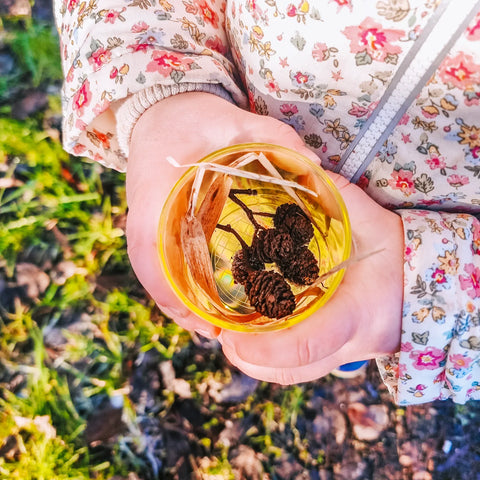Outdoor Play with tickit in Winter and Spring by Vicki Moulding
Feb 20, 2024
It can be hard to get outdoors in Winter when it’s very cold, damp and dark. However, there are perks to these cold months – especially when those early signs of Spring start appearing such as the clear blue skies and the tiny shoots in the ground! I’m going to share with you some wonderful ways to still enjoy nature in the colder months… as well as play in them!
Nature treasure hunt
Using the tickit Translucent Colour Viewers – go on a treasure hunt and encourage your little ones to look for natural treasures such as crisp leaves, alder cones, berries, seeds, or catkins. If you have ice or snow too, you can put some in your viewers and use the magnifying glass in the lid to look more closely.
Towards the end of Winter, when Spring is well on its way, you can use the colour viewers to do a colour nature hunt. Using the green viewer, encourage your children to find things that are green; examples are leaves, grass or stems. In the yellow viewer, see if they can find some yellow flowers like buttercups or daffodils.
What else can we do?
The colour viewers are translucent, so the light shines through them beautifully. Once you have collected lots of treasures in them, pop them onto a light panel and inspect your findings more closely. Remember to swap your viewer lids for their magnifying glass!
Colour Paddle Adventures
Using the tickit Translucent Colour Paddles on adventures can really encourage colour exploration within nature. The paddles have holes in, so you can use twine or string to tie them together, so they’re much easier to carry around. The joy about being outdoors is that there is so much to discover and learn about. There are lots of colours and patterns and textures to discuss. Using the colour paddle on your walks can encourage children to explore; seeing the world through different coloured lenses can be a fascinating experience. It’s also a great way for them to focus more on the colours around them. They can match flowers, leaves, and bugs to the colours of their paddles.
Nature paint brushes
It’s time to put your coats on! Head out and collect some nature items you think could make brilliant brushes! For example, long pieces of grass, bushy branches or bundled up leaves! You’ll also need sticks too, so ensure you pick some thin sticks! This is a great way to encourage children to connect with nature. It also helps them to think critically about their decisions; by giving them the power to choose their own tools for their “paint brushes” it really gives them an opportunity to be creative! When you have found your items, use string or twine to tie them about 2 inches onto the sticks. Make sure they’re secured tightly so they don’t come loose!
Time to get creative! Use paper, newspaper, or cardboard – add acrylic or poster paint and use the nature brushes to make marks!
If you have babies or younger children who still mouth materials – there are ways to create taste-safe options that won’t harm them if it becomes digested by using alternatives such as yoghurt and food colouring or whipped cream and food colouring.

Make a minibeast garden
A great way to spend time in the garden is to make a mini version! Using things around you like soil, grass, leaves, sticks, rocks, or pebbles, you can make a miniature eco-system and add in the tickit Wooden Minibeast Blocks. It really helps to develop a child’s understanding by using real materials like soil and leaves to help them understand the nature elements that the creatures live in. Creating a miniature garden is a wonderful way for them to role play and have a sensory experience of getting hands on with nature too – talking about the different textures and really getting their hands mucky. You can help them discover even more by using magnifying glasses. The tickit Wooden Hand Lens is a great tool to get up close and really inspect the materials that have been collected from outside.
What else can we do?
Using the wooden minibeast blocks; you can encourage your child(ren) to name the insects, talk about where they live (in the soil, on flowers, in wood etc) and talk about what they eat or whether they have any important jobs they do.
Make a bird feeder
In Winter, birds are hungry and you’ll often see them looking for food. As many insects bury themselves underground or hide in wood, birds struggle to find food. Making a bird feeder is a great way to help nature and is a lovely way to encourage birds into your surroundings!
All you need is:
- Bird seeds (sunflower seeds, mealworms, or good quality peanuts)
- Peanut butter
- Pinecones
- Twine or string
This is very simple for many children to be able to do themselves, younger children may need some support. Firstly, you need to cover your pinecones in the peanut butter and then roll them into the bird seed mixture. The bird seeds will stick to pinecones, ready for the birds to find! You need to attach string or twine and then you can hang them onto trees and branches. Try and hang them higher up, as many birds don’t like to come too low down. Grab some binoculars and see how many birds you can see!

Being outside in nature has so many benefits; even in the colder weather! It’s important to stay warm so wearing enough clothing and the right layers can really help… so you and your little ones don’t need to compromise on fun and can still explore and play outdoors!
Witten by Vicki Moulding, mother to three and Home Educator.








